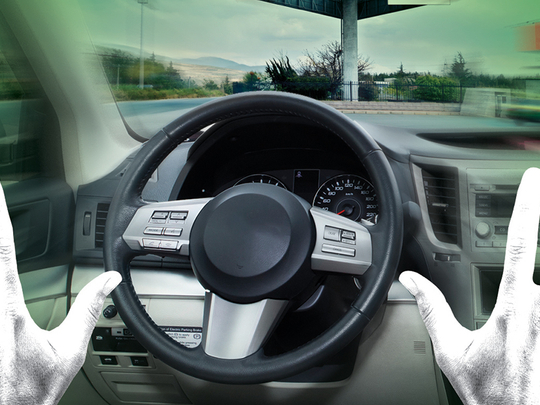
Only a decade ago, driverless cars were part of science fiction. Movies like Minority Report, A.I. (Artificial Intelligence), and I, Robot featured driverless-car chases in “futuristic” settings. But now, cars without drivers are around the corner (literally and figuratively), being tested on our roads, planned for taxi companies and already getting into accidents — one incident even resulting in the death of a passenger.
How did that stunningly fast (r)evolution happen and does it bring with it issues that we need to worry about, or at least prepare for?
Driverless cars actually go back at least 30 or 40 years, both in concept and simple prototypes. Their basic idea is simple: Let the car collect all information from the environment (road features, cars nearby, weather, map of all possible routes, etc) and the car itself (engine, steering, brakes) using cameras, mini-radars, GPS systems, etc from which the car’s computer can control the vehicle and steer it at every instant in going from Point A to Point B. It is in fact the fast advances in these mechanical, electronic and informational aspects of cars and driving that have resulted in this driverless leap.
We have already benefited from these advances. Many of our car models offer cruise control, built-in GPS, cameras and sensors, parking assistance, etc. Indeed, some cars already can park themselves without the driver doing anything. These features represent the first of six levels in driverless car technology, from no automation or driver assistance to partial, conditional, high and full automation, the latter being the ultimate autonomous car solution — the science fiction that is soon to become reality ...
Major companies such as Google, Daimler and Tesla have invested hundreds of millions of dollars in developing these cars. Indeed, they are totally convinced that not only will the market (we) welcome them enthusiastically, these will represent an important leap in technology and human civilisation.
Indeed, these cars will presumably reduce accidents by as much as 90 per cent! Why? Because humans are, well, humans: They make (too many) mistakes, which result in accidents, often lethal. Drivers tend to lose concentration, due to distraction or fatigue. Moreover, some people drive carelessly, even recklessly: How often have you had someone switch lanes without warning and jump in front of you, making you hit the brakes? Computers don’t do that; they determine and carry out the safest moves. This in fact not only greatly reduces accidents, but smooths out traffic, making it more fluid, allowing more cars to travel on any road and reducing commuting times. And that’s another huge advantage and prospect of driverless cars.
Another benefit is the fact that people with disability will be able to have their own cars and not rely on taxis. In fact, taxis will themselves become driverless. And people who cannot drive, being too old or having various disabilities, including just poor eyesight, many prefer to have their own cars, for example to drive to a remote place for several hours or other needs. Driverless cars will offer the perfect solution.
Yet another benefit will be the reduction in parking spaces needed in the city, since driverless cars can be shared and can keep taking one person after another from one place to another. Moreover, a more efficient traffic system will also result in a reduction of pollutants and greenhouse gases — a better air quality and cleaner environment.
That is the rosy version of the future. As always, things are not that simple. As I mentioned above, and as you may have heard, last May, a Tesla car crashed into a big truck, killing the person who was in the car. This did not produce the panic and backlash against driverless cars that one may expect. After all, car crashes occur by the thousands each day and Tesla was quick to point to statistics of accidents and deaths per thousand miles, showing that tests of driverless cars have so far been safer than our normal cars. Still, first impressions can be damaging and Tesla, Google and Daimler know that their cars will be held to very high standards.
There are other issues to address before we are all ready to embrace the driverless revolution. In accidents (they are bound to occur, even if infrequently), who will be held responsible, particularly in cases of death? The manufacturing company? The computer and software designers? What if the road conditions were just overly bad? I’m sure we can all think of various complicated cases.
One aspect of the topic that fascinates me is what ethical rules and standards will be programmed into the car’s computer to decide how to choose between options when each has some negative, perhaps lethal consequences? Kill the child who is crossing the road, running after a ball, or crash the car and its passenger into a pole or a wall?
Surveys of public attitudes about driverless cars have shown a steady increase in people’s acceptance of them. It remains to be seen how the actual experience and reaction of people will be when the cars become an everyday reality. In any case, we need to prepare for the imminent prospects.
Nidhal Guessoum is a professor of Physics and Astronomy at the American University of Sharjah. You can follow him on Twitter at: www.twitter.com/@NidhalGuessoum.










